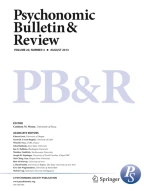1970Accesses
92Citations
3 Altmetric
Abstract
In the present study, we examined the hypothesis that perceptual load is the primary factor that determines the efficiency of attentional selection. Participants performed a visual search task under conditions of high- and low-load. In line with the perceptual load hypothesis, presenting conditions of highand low-load in separate blocks of trials resulted in processing of to-be-ignored stimuli only in the lowload condition (Experiment 1). However when high- and low-load conditions were randomly mixed in blocks of trials, the participants showed processing of to-be-ignored stimuli in both conditions, suggesting that high perceptual load is not necessarily sufficient to obtain perceptual selectivity (Experiment 2). An analysis of intertrial transition effects showed that on high-load trials, processing of to-be-ignored stimuli occurred only when the previous trial was a low-load trial. The results suggest that low perceptual load can engender broad attentional processing. On the other hand, when a high-load trial was preceded by another high-load trial, little processing of task-irrelevant stimuli was observed. The present results are discussed in terms of the interaction between expectancies and bottom-up factors in the efficiency of attentional selection.
Article PDF
Explore related subjects
Discover the latest articles, books and news in related subjects, suggested using machine learning.Avoid common mistakes on your manuscript.
References
Allport, D. A. (1980).Attention and performance. InG. Claxton (Ed.),Cognitive psychology: New directions (pp. 112–153). London: Routledge & Kegan Paul.
Allport, D. A., Styles, E. A., &Hsieh, S. (1994). Shifting intentional set: Exploring the dynamic control of tasks. In C. Umiltà & M. Moscovitch (Eds.),Attention and performance XV: Conscious and nonconscious information processing (pp. 421–452). Cambridge, MA: MIT Press.
Broadbent, D. E. (1971).Decision and stress. London: Academic Press.
Broadbent, D. E. (1982). Task combination and the selective intake of information.Acta Psychologica,50, 253–290.
Bundesen, C. (1990). A theory of visual attention.Psychological Review,97, 523–547.
Deutsch, J. A., &Deutsch, D. (1963). Attention: Some theoretical considerations.Psychological Review,70, 51–61.
Gibson, B. S., &Peterson, M. A. (2001). Inattentional blindness and attentional capture: Functional consequences of serial search for the perception of visual salience. In C. L. Folk & B. S. Gibson (Eds.),Attraction, distraction, and action: Interdisciplinary perspectives on attentional capture (pp. 51–76). Oxford, U.K.: Elsevier.
Johnson, D. N., McGrath, A., &McNeil, C. (2002). Cuing interacts with perceptual load in visual search.Psychological Science,13, 284–287.
Kahneman, D., &Treisman, A. (1984). Changing views of attention and automaticity. In R. Parasuraman & D. R. Davies (Eds.),Varieties of attention (pp. 29–61). New York: Academic Press.
Lavie, N. (1995). Perceptual load as a necessary condition for selective attention.Journal of Experimental Psychology: Human Perception & Performance,21, 451–468.
Lavie, N. (2000). Selective attention and cognitive control: Dissociating attentional functions through different types of load. In In S. Monsell & J. Driver (Eds.),Attention and Performance XVIII: Control of cognitive processes (pp.175–194). Cambridge, MA: MIT Press.
Lavie, N., &Cox, S. (1997). On the efficiency of visual selective attention: Efficient visual search leads to inefficient distractor rejection.Psychological Science,8, 395–398.
Lavie, N. &Tsal Y. (1994). Perceptual load as a major determinant of the locus of selection in visual attention.Perception & Psychophysics,56, 183–197.
Los, S. A. (1996). Identifying stimuli of different perceptual categories in pure and mixed blocks of trials: Evidence for stimulus-driven switch costs.Acta Psychologica,103, 173–205.
Maljkovic, V., &Nakayama, K. (2000). Priming of popout: III. A short-term implicit memory system beneficial for rapid target selection.Visual Cognition,7, 571–595.
Theeuwes, J. (1991). Exogenous and endogenous control of attention: The effect of visual onsets and offsets.Perception & Psychophysics,49, 83–90.
Theeuwes, J. (1992). Perceptual selectivity for color and form.Perception & Psychophysics,51, 599–606.
Theeuwes, J. (1993). Visual selective attention: A theoretical analysis.Acta Psychologica,83, 93–154.
Theeuwes, J. (1994). Stimulus-driven capture and attentional set: Selective search for color and visual abrupt onsets.Journal of Experimental Psychology: Human Perception & Performance,20, 799–806.
Theeuwes, J. (2004). Top-down search strategies cannot override attentional capture.Psychonomic Bulletin & Review,11, 65–70.
Treisman, A. M., &Gelade, G. (1980). A feature integration theory of attention.Cognitive Psychology,12, 97–136.
Yantis, S., &Johnston, J. C. (1990). On the locus of visual selection: Evidence from focused attention tasks.Journal of Experimental Psychology: Human Perception & Performance,16, 135–149.
Yantis, S., &Jonides, J. (1990). Abrupt visual onsets and selective attention: Voluntary versus automatic allocation.Journal of Experimental Psychology: Human Perception & Performance,16, 121–134.
Author information
Authors and Affiliations
Department of Cognitive Psychology, Vrije Universiteit, Van Der Boechorststraat 1, 1081 BT, Amsterdam, The Netherlands
Jan Theeuwes
University of Illinois, Urbana-Champaign, Illinois
Arthur F. Kramer & Artem V. Belopolsky
- Jan Theeuwes
Search author on:PubMed Google Scholar
- Arthur F. Kramer
Search author on:PubMed Google Scholar
- Artem V. Belopolsky
Search author on:PubMed Google Scholar
Corresponding author
Correspondence toJan Theeuwes.
Rights and permissions
About this article
Cite this article
Theeuwes, J., Kramer, A.F. & Belopolsky, A.V. Attentional set interacts with perceptual load in visual search.Psychonomic Bulletin & Review11, 697–702 (2004). https://doi.org/10.3758/BF03196622
Received:
Accepted:
Issue date:
Share this article
Anyone you share the following link with will be able to read this content:
Sorry, a shareable link is not currently available for this article.
Provided by the Springer Nature SharedIt content-sharing initiative
